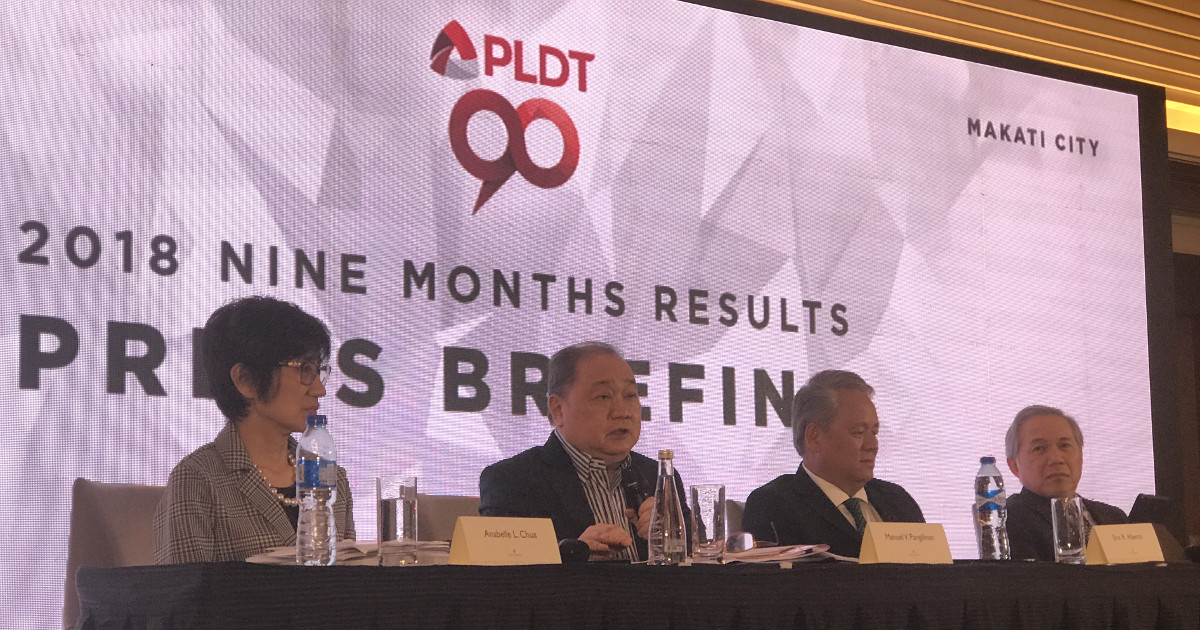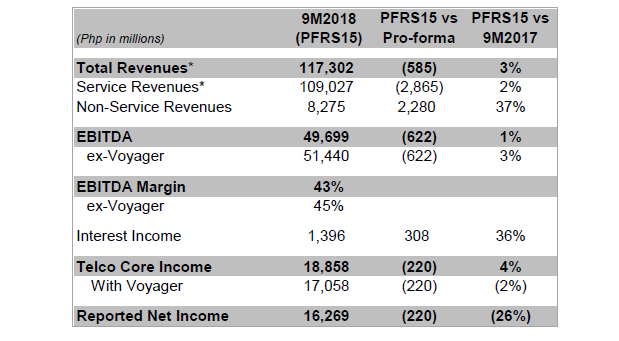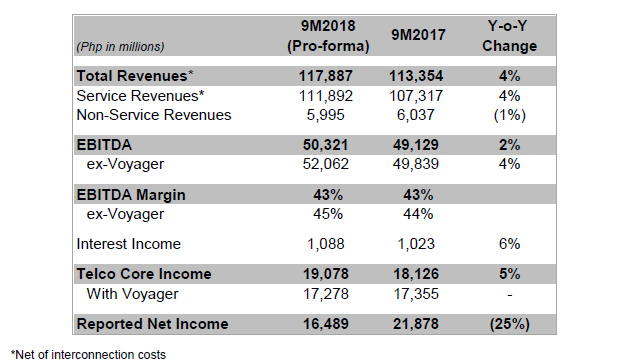
ON A PRO-FORMA BASIS: SERVICE REVENUES FOR 9M18 UP 4% YEAR-ON-YEAR AT P111.9 BILLION EXCLUDING ILD/NLD, CONSOLIDATED SERVICE REVENUES ROSE 7%
COMBINED HOME, ENTERPRISE AND INDIVIDUAL REVENUES, OR 90% OF TOTAL CONSOLIDATED REVENUES, ROSE BY 8% TO P101.2 BILLION
HOME AND ENTERPRISE REVENUES ROSE 12% AND 10%, RESPECTIVELY
INDIVIDUAL REVENUES HIGHER 4% YEAR-ON-YEAR AND 3% QUARTER-ON-QUARTER – FOURTH CONSECUTIVE QUARTER OF GROWTH
DATA/BROADBAND REVENUES GREW BY 36% TO P66.0 BILLION, NOW 59% OF TOTAL CONSOLIDATED REVENUES
CONSOLIDATED EBITDA ROSE BY 2% TO P50.3 BILLION, OR BY 4% (EX-VOYAGER) TO P52.1 BILLION, MARGIN AT 45%
TELCO CORE INCOME (EX-VOYAGER AND ASSET SALES) INCREASED BY 5% TO P19.1 BILLION
REPORTED NET INCOME OF P16.5 BILLION, INCLUDING ACCELERATED DEPRECIATION OF P4.5 BILLION
SMART, TNT AND SUN LAUNCH “VIDEO EVERY DAY” OFFERS
SMART NETWORK IS RECOGNIZED AS PROVIDER OF “BEST VIDEO EXPERIENCE IN THE PHILIPPINES” -- BY OPEN SIGNAL
PLDT AND SMART TO TRANSFORM CLARK INTO FIRST 5G CITY IN THE PHILIPPINES
KKR AND TENCENT INVESTMENT IN VOYAGER TO CLOSE IN 4Q18
CORE INCOME GUIDANCE FOR 2018 OF P23-24 BILLION (EX-VOYAGER AND PRE-IFRS 15) AFFIRMED DESPITE HEADWINDS

PLDT Inc. (“PLDT”) (PSE: TEL) (NYSE:PHI) today announced its unaudited financial and operating results for the first nine months of 2018 (9M18) with Consolidated Service Revenues (net of interconnection costs) reaching P109.0 billion based on the new accounting standard PFRS 15, a 2% increase from the same period in 2017. Consolidated EBITDA grew by 1% to P49.7 billion yearon- year. Telco core income rose by 4% to P18.9 billion. Including the gain from the sale of shares in Rocket Internet and losses from Voyager, core income stood at P17.1 billion.
The effect of the adoption of PRFS 15 on the Company’s income statement for the first nine months of 2018 is shown below:

For an apple-to-apple comparison, the Company’s results in the first nine months of 2018 are shown side-by-side with those of the same period last year on a pro-forma PAS18 basis below:

Pro-forma PAS18 consolidated service revenues for the period to the end of September totaled P111.9 billion, 4% higher than a year ago. Revenues in the third quarter reached P37.5 billion, the sixth consecutive quarter of sequential increases.
Excluding international and national long distance (ILD/NLD) revenues, service revenues amounted to P104.9 billion, up 7%. The third quarter of 2018 was the seventh (7th) consecutive quarter showing service revenue increases.
Pro-forma PAS18 consolidated EBITDA rose by 2% to P50.3 billion year on year, with EBITDA margin of 43%. Excluding Voyager, EBITDA was higher by 4% at P52.1 billion and margin at 45%.
Telco core income (i.e., excluding Voyager) grew 5% to P19.1 billion versus the previous year.
Reported Net Income stood at P16.5 billion, impacted by, among others:
• Accelerated depreciation of P4.5 billion in connection with the shortened estimated useful life of network assets affected by PLDT’s network upgrade
• Revaluation gain of P1.1 billion on the remaining Rocket Internet shares
As of end-September 2018, Consolidated Net Debt and Net Debt to EBITDA stood at US$2.4 billion and 1.94x respectively. Gross Debt amounted to US$3.3 billion, of which only US$0.3 billion or 8% was unhedged. Fixed rate loans, post interest-rate swaps, comprised 89% of total loans while floating rate loans made up the balance of 11% of the total. The average interest cost (pre-tax) was 4.5%.
As of end-September 2018, PLDT’s credit ratings remained at investment grade.
Maintaining the growth momentum
Home continued to lead the way for the Group, growing revenues by 12% to P27.3 billion in 9M18 and accounting for 24% of consolidated service revenues, 75% of which were contributed by data and broadband.
The third quarter registered the 14th quarter of sequential revenue growth from the first quarter of 2015. Revenue gains in the third quarter would have been more substantial if Home installation activities had not been constrained by a Department of Labor and Employment (DOLE) Order that stopped the operations of 38 of PLDT’s service contractors that affected, among others, installation, repair/maintenance and call center services.
Service revenues of Enterprise grew 10% year on year by P2.6 billion to P28.4 billion in 9M18, representing 25% of total service revenues. Enterprise revenues were bolstered by a 12% increase to P18.2 billion in data and broadband which now comprise 64% of total Enterprise revenues. In particular, data center revenues grew by 21% while corporate data revenues rose 12%.
Individual Wireless services revenues continued to gain momentum – rising 4% to P45.5 billion as of 9M18. This is the fourth consecutive quarter of growth for this business group.
The 4% growth in 9M18 stands in sharp contrast to the 14% or P7.1 billion year-on-year decline registered in the first nine months of 2017. Effectively, this represents a combined turnaround of P8.8 billion.
The increase in revenues of Individual Wireless was boosted by a growth in mobile internet revenues versus a year ago as mobile data traffic grew by 97% in the same period, as a results of higher usage.
The combined Home, Enterprise and Individual Wireless service revenues added up to P101.2 billion in 9M18, accounting for 90% of total service revenues, and posting an 8% or P7.2 billion year on year increase. This represents a marked turnaround from the P1.8 billion year-on-year decline in 9M17 or a total positive swing of P9.1 billion.
As cited earlier, data and broadband continue to power the growth of the Home, Enterprise and Individual Wireless groups, representing 75%, 64% and 59% of service revenues, respectively. Revenues from this group of services grew 36% to P66.0 billion.
“Despite the extraordinary challenges posed by the DOLE Order, we have sustained the double digit growth of Home and Enterprise and added momentum to the recovery of our Individual Wireless business,” said Ernesto R. Alberto, PLDT and Smart Executive Vice President and Chief Revenue Officer.
Network roll-out surpasses targets
The rapid pace of its network transformation program has enabled PLDT to surpass several key full-year 2018 roll-out targets by end-9M18.
One critical activity is the expansion of PLDT’s fiber optic cable network. By end- September 2018, PLDT’s total fiber footprint – consisting chiefly of transmission and distribution facilities – had reached 221,000 kilometers (kms.), exceeding the full year 2018 target of 210,000 kms. This has provided the vital underpinning for the expansion of the group’s fixed and mobile networks.
By end-9M18, PLDT Home’s fiber coverage had reached 5.75 million homes, surpassing the full year 2018 target of 5.3 million homes. At the same time, total capacity reached 2.25 million ports – more than double the count as of end-2017 and above the 2.20 million ports targeted for 2018. At the end of September, there were 1.25 million ports available for subscription.
Meantime, Smart installed about 5,700 new LTE or 4G base stations, boosting its total count to about 14,400 LTE base stations nationwide – 65% more than its end-2017 count. It also added about a thousand 3G base stations in the same period, raising the total count to about 11,000.
“The accelerated roll-out of PLDT’s fiber network has placed us in a good position to provide all PLDT customers with fiber-powered broadband services within the next 12 to 18 months. In addition, Smart’s stepped up deployment of LTE, LTE-Advanced and 3G facilities will enable us to fulfill our commitment to the government to provide mobile broadband services to over 90% of the country’s cities and municipalities by end-2018,” said Mario G. Tamayo, Senior Vice President for network planning and engineering for PLDT and Smart.
Video driving mobile data
The aggressive network transformation undertaken by PLDT and Smart has provided powerful boosts to their respective businesses which are increasingly relying on the customer’s use of broadband and digital services, particularly video viewing.
Smart’s rapid deployment of its LTE and LTE-Advanced facilities for example enabled it to pull off its hugely successful YouTube promo where customers enjoyed one-hour of free viewing per day of the world’s most popular video website if they bought qualified mobile data packs.
As a result of that promo, the number of YouTube viewers among Smart, TNT and Sun customers jumped by over six times from the start of the offer in April to October this year. During that period, the volume of data traffic soared by over 13 times. Moreover, even while offering YouTube viewing for free, average revenue per prepaid subscriber increased by 9%.
Despite the huge increase in data traffic, Smart delivered quality video viewing experience for those availing of the YouTube promo. In its latest report released last week, international mobile analytics company OpenSignal cited Smart for providing customers the best video experience in the Philippines.
Covering the period May to August 2018 at the height of the YouTube promo, that report provided a breakdown of the performance of mobile operators in Asia. It said that Smart garnered a video experience score of 42.2, well ahead of the scores of the competitor and those of major U. S. carriers. This comes on the heels of earlier reports of OpenSignal and Ookla, the global leader in internet testing and analysis that showed Smart provides that fastest LTE service in the country. [These network achievements are, to a great extent, enabled by the spectrum bank from the co-acquisition of San Miguel’s telecoms business in 2016.]
“We are immensely pleased by the results of the YouTube promo. This early, even during the promo period, we are already gaining incremental revenues. And because of the great work done by our network team, the customer experience of video viewing has been very positive. This has placed us in an excellent position to offer more compelling video services on a sustainable basis,” said Oscar A. Reyes, Jr., Senior Vice President of Consumer Market Development for PLDT and Smart.
Building on the success of the YouTube promo, Smart launched on November 6 new data packs loaded with “Video Every Day” – offering access not only to YouTube, but also to other popular video sites such as iflix, iwantTV, NBA League Pass, Discovery kids and Cignal Play.
Video also boosts Home fiber
The demand for better online video viewing is also a key factor boosting demand for fiber to the home service. This is because the video viewing habits of Filipinos are undergoing a tectonic shift to online services that enable them to watch programs when and where they want to – either at home or while on the move.
A recent study of Limelight Networks, “The State of Online Video 2018”, found that out of the 10 countries covered, Filipinos watch the most online video each week at 8 hours and 46 minutes – surpassing online video viewers in the United States and India. Moreover, Filipinos – along with Indians and Singaporeans – now watch more online video than traditional broadcast television.
Driven by this shift in viewing habits, Home broadband penetration reached an all-time high of just under 2 million customers in 9M18. This represents an 8% increase year on year in unique data service subscribers. Throughout the country, the demand is for fiberpowered Home broadband that can provide quality viewing of online video.
To further improve the customer experience on Home fiber services, PLDT Home has, over the past quarter, given a free speed boost to fiber broadband subscribers. Customers who signed up for Fibr Plan 1699 with a speed of 5 Mbps for example now enjoy 10 Mbps. Meantime, PLDT Home launched its partnership with Google WiFi to extend fiber-powered WiFi data coverage to every part of the customer’s residence.
Moving forward, Home is set to introduce new digital services with online video at the cutting edge.
Focus on Digital services
For the PLDT Enterprise group, the focus remains on pushing data and digital services such as data centers and cloud infrastructure and Software-as-a-Service that companies are embracing with rising enthusiasm. One digital service that is rapidly growing is Cyber Security, as more and more companies and government agencies wake up to the growing threats posed by malicious malware and cyber attacks.
The Enterprise group also took the lead in reaching an agreement with the Clark Development Corporation and the Bases Conversion and Development Authority to launch the Clark Freeport Zone (CFZ) as the country’s first Smart 5G City. Under the Memorandum of Understanding signed this week with the CDC and BCDA, PLDT and Smart will deploy 5G base stations in the CFZ over the next few months, with the first to be installed this November.
“The growing expectation is that the initial use cases for 5G technology will be enterprise applications in fields like transportation, traffic management and health care. We will work with the zone authorities and businesses in the CFZ to develop intelligent services that can take advantage of 5G’s ability to provide ultra-fast, real-time, massive connectivity,” said Juan Victor Hernandez, PLDT and Smart Senior Vice President for Enterprise Business.
Voyager gets fresh funding
In early October 2018, Voyager Innovation signed subscription agreements to raise a total of US$175 million of new funding via the issuance of new shares to leading global investment firm KKR (NYSE: KKR), and Tencent Holdings Ltd. (0700.HK), a leading provider of internet services in China.
The new funding – the largest investment in a Philippine tech company to-date - is expected to cover Voyager’s cash requirements for at least 2 years. This will in turn allow PLDT to direct available funds to support its massive capex program.
Other investors are expected to inject more capital into Voyager and as new funding from follower investors comes in, PLDT’s ownership share is expected to fall below 50%, while remaining the largest single shareholder.
The transaction with the lead investors KKR and Tencent is expected to close in the fourth quarter of this year.
“The infusion of fresh capital and the global expertise of the new lead investors will enable Voyager to step up its efforts to make mobile payments and other digital services more accessible to Filipinos. This will help speed up digital and financial inclusion in the country and benefit the many Filipinos who remain unbanked and have little or no access to the financial system,” said Orlando B. Vea, Voyager President and CEO.
Conclusion
“The solid success of our YouTube promo is gratifying on several counts. First, it shows how much progress our network transformation efforts have made in the past two years. Particularly, the roll out of Smart’s LTE and LTE-Advanced services that have delivered to our customers the country’s best mobile video experience despite the massive increase in data traffic triggered by the promo. Second, it highlights how effectively the increased collaboration between our network and revenue groups is helping us attain our priority objectives. Third, it has placed our Individual Wireless business in a much better position to grow sustainably, powered by data and digital services, led by online video. Combined with our robust Home and Enterprise businesses, our Wireless business can then provide an even more powerful lift to the overall business of PLDT and Smart,” said Manuel V. Pangilinan, PLDT and Smart Chairman, President and Chief Executive Officer.
“This will enable us to deal more effectively with the challenges that will posed by heightened competition from players old and new. As PLDT celebrates its 90th anniversary this November, this will also give us the means and opportunity to further pursue the internal transformation that we must accomplish in order to thrive in the rapidly developing digital economy. Given these developments, we maintain our guidance that the full-year telco core income for 2018 (excluding Voyager) will be in the range of P23-24 billion, and, that our capex will reach P58 billion as budgeted,” he added.

